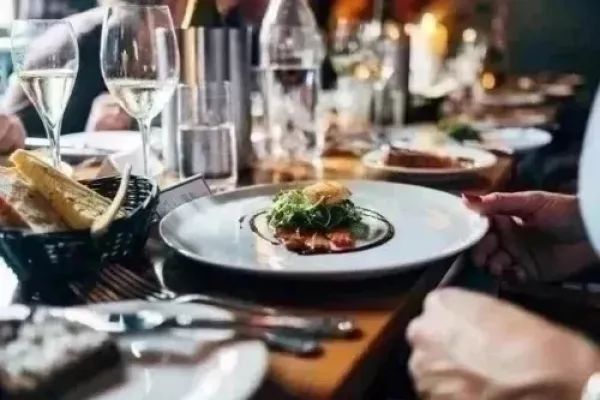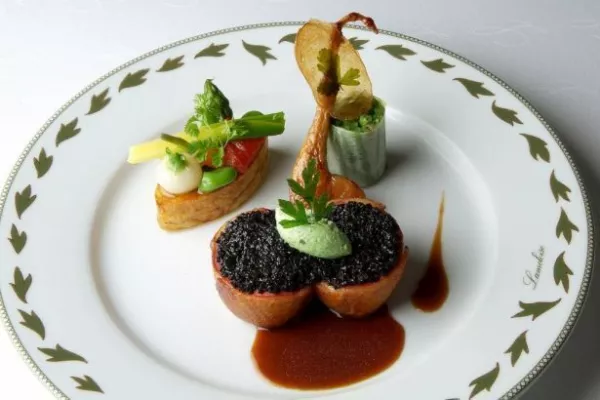I was so happy last week in Sydney, I gripped my wooden spoon like a toddler and grinned between bites of sliced, unripe macadamia nuts, writes Bloomberg food critic Tejal Rao.
These tasted of nothing and everything, of an exuberant and pristine freshness, splashed with an ice cold broth made from spanner crab and a little rose oil. Rene Redzepi, the chef who brought the dish to the table, compared their delicate crispness to stepping on frozen puddles in Denmark when he was a little boy. It was a fact that seemed too cute to be true, but even before he said it, there was something nostalgic about the dish, something sweet and familiar.
Australia is the world’s largest macadamia producer, and the nut is so ubiquitous here that it’s practically a cliché to serve it. So Redzepi persuaded growers to sell him unripe nuts in the shell, pale and tender, when they looked and tasted almost nothing like the dry, compact things we’re used to.
A team from his Copenhagen restaurant Noma spent about two months researching Australian ingredients and another experimenting with them in a test kitchen to try to surprise diners with moments like this one. And Redzepi, whose restaurant has been named best in the world four times by Restaurant magazine, has the following of an international pop star: Tickets to the 10-week popup were gone within minutes online at $340 a person for 12 courses, not including wine ($220 more) and travel (my ticket cost $2,000 from New York City), and the wait list goes 27,000 names long. The restaurant had set aside a few tickets for press to buy at full price, which is how I managed to get a seat.
Cooks travelled to Tasmania to scout fish and seaweed, to Victoria for mussels, to the Northern Territory for magpie geese, then composed a menu focused almost entirely on seafood. Meat does sneak in: When I went, a spectacular bowl of warm snow crab in a sauce of cured egg yolk had a gamey little secret—fermented kangaroo juice. Like so much of the meal at Noma, the flavours were big and powerful but not discordant, getting right to the heart of where the ocean meets the land.
A scallop pie, which was more of a delicate little tart, somehow pulled off the dense, melting texture of a foie gras terrine. The pastry was made with seaweed, so it turned a pale, sea foam green. The deeply concentrated flavor of dried scallop in the filling was dark and dicey, but a confetti of pink and purple lantana, a weedy blooming perennial with a perfume like honeysuckle, softened it out.
Here’s one way to show people an unfamiliar ingredient is luxurious: Serve it inside an intricately woven palm leaf. I found browned milk skin there, as soft and thick as a tortilla, carrying pieces of marron, a big crayfish from the rivers of Western Australia. Noma pioneered a certain level of studied casualness in expensive dining rooms, and it sticks to it here—you pick this one up with your hands, like a taco, and make a bit of a mess.
Steak would be way too obvious; forget steak. The heaviest course on the menu is a nice hunk of abalone, the marvelous sea snail, as a fat, crisp-edged schnitzel. The undressed greens and flowers around it are in giddy abundance, almost overwhelming, and there are chains of beaded seaweed that look like a mermaid’s family heirloom.
Though you’ll find a tiny, fairy-size bouquet on the plate, the dish hasn’t been tweaked and tweezered to death. You’re expected to get in there, to do some of the work yourself: Squeeze the sour, floral guts out of a finger lime onto the abalone meat and dip the raw greens in a syrupy mushroom sauce.
The popup’s home this year is in line with Noma’s Scandi-chic aesthetic: a bright but industrial dining room in Barangaroo, overlooking Sydney’s increasingly affluent Darling Harbour, where the gulls and the choppy water are just visible through sheer curtains. The tables are sparsely decorated with wildflowers and candles, and the staff wears natural-looking linens the colors of sand and rock.
The $6 billion commercial development that houses Noma, Barangaroo South, should be complete in the next four to five years with luxury residential high rises and offices, restaurants and retail, and a fancy hotel, but that name, Barangaroo, comes from an aboriginal Cammeraygal woman who fished along this shore. Her husband, Bennelong, was captured by English settlers and later taken to England. Redzepi evokes Barangaroo, the woman, and the complicated history of Sydney Harbor.
When the area was being cleared for new development in 1980, not far from where Noma’s cooks are cracking open oysters for the shellfish course, an aboriginal campsite was discovered with an archive of shells: cockles, rock and mud oysters, whelks, hairy mussels.
Noma’s shellfish course is a spare homage. To make it, Redzepi uses crocodile fat to solidify the thin, crystalline film that forms over the surface of chicken stock, then drapes some over each half-shell. The result is slick bulges of shellfish under salty, translucent golden veils that slacken and stick to your teeth. It’s gorgeous when you land a silvery mussel, or a fat oyster, but one clam was so aggressively dank and bitter that I was scared I might not keep it down.
When it comes to animals that grow in deep water, maybe we’re not always meant to find them, I thought, let alone bring them back up to land, pry them open, and swallow them raw and greased with crocodile fat.
Service is terrific, from the cheerleader-level energetic greetings as each group of diners comes in, to the bubbly sendoffs as they leave. The staff is so friendly and unobtrusive that you almost don’t realize how laser-focused they are on taking care of you.
Every table seems to get the VIP treatment, not just the journalists known to the house, the Australian television personalities, and the local chefs and winemakers. Sommelier Mads Kleppe put together pairings, which include small local producers, many of which he visited over a series of trips last year. The first glass you’ll taste is a profoundly delicious version of a snakebite, a shandy of sorts, made with a mix of apple and pear ciders with aged ale and sour ale from Two Meter Tall in New Zealand. I wanted to buy a bottle of the lush, cloudy orange wine he served from Pyramid Valley Vineyards to take home (only $32), but naturally, only 175 cases were produced, and the shops I called were out of stock.
Dessert is full of winks to contemporary Australian foodstuffs. Malcolm Livingston’s riff on the cake rolled in chocolate and coconut, the Lamington, is exquisite. Instead of a light sponge, there’s a cold, rummy foam, hard enough on your spoon to be satisfying, with grated milk and a gently sour tamarind jam at the bottom.
The ice cream bar on a real stick, instead of a popsicle stick, is built like the popular local treat, the Gaytime, but takes a leap and imagines what the 1950s-era bar would look like if it were made from native ingredients. It draws its toffee sweetness from peanut milk and freekeh, and the dark shell has a softly chewy, almost oily slick. As you go, the frozen center doesn’t drip. It’s like standing in front of the ice cream truck in the sun, after a long, hard swim, slowing down time.
When the Fat Duck popped up in Melbourne last year, Heston Blumenthal recreated many of the dishes he was famous for serving in Bray, England, right down to the last detail. The point was to give a new audience on the other side of the planet access to existing delights. Redzepi’s adventurous approach, to come up with an entirely different menu, from an entirely new set of ingredients, requires funding, research, and time for experimentation, as well as an international fan base that includes thefood establishment, eager to experience how the chef sees another part of the world.
Last year the entire Noma team set up shop in Japan, home to one of the world's most well-respected and formally established fine dining cultures, a place where home-grown products are already highly valued, and it’s not unusual for a single ripe Densuke watermelon to go for thousands of dollars at auction. Australia is not quite there yet, but just as Noma helped make gull eggs and birch sap trendy, Redzepi is sprinkling some of his fairy dust on local ingredients still uncommon in mainstream restaurants.
The seductive motif of the explorer has always been at the heart of Redzepi’s narrative. The roots of his break with eurocentric haute cuisine, and the growth of his own style, can be traced back to a trip he took in 2003, when he was 25 and still an underdog, to research the foodways of the Faroe Islands, Iceland, and Greenland and integrate them into his kitchen.
In the years following that Scandinavian research trip, Noma went on to become one of the most influential restaurants of our time, and Redzepi one of our biggest celebrity chefs. In his cookbook, he calls that pivotal trip his “first voyage of discovery,” and I kept thinking about that phrase last week, about what it might mean in a country with a violent colonial past, where Redzepi is an outsider.
Revering native ingredients is now almost standard practice among a small group of fine dining chefs—all over the world, you’ll find them excavating the wilderness of their own backyards for the esoteric, mining history, and high-fiving each other when they find a gem.
There are a few ways of looking at this. The first is as a kind of cultural appropriation: Food is culture, and a renewed appreciation for what was forgotten is possible only after these foods, and the people who valued them, have been systematically trivialized.
Another way of looking at the work, the way I started to by the end of my meal at Noma, is as a kind of culinary revision. When the cooks are brilliant, when their research is thorough, when they ask you to see and taste things so much differently than they are, maybe dinner can also be a deliciously subversive story told in 12 parts.
And in this version of the story everythins, even a macadamia nut, gets the chance to be something new.
News by Bloomberg, edited by Hospitality Ireland









